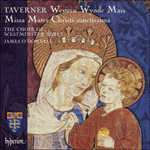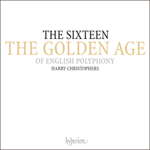
Welcome to Hyperion Records, a British classical label devoted to presenting high-quality recordings of music of all styles and from all periods from the twelfth century to the twenty-first.
Hyperion offers both CDs, and downloads in a number of formats. The site is also available in several languages.
Please use the dropdown buttons to set your preferred options, or use the checkbox to accept the defaults.

| Westminster Abbey Choir, James O'Donnell (conductor)» More |
Missa Mater Christi sanctissima—like most English cyclic Mass settings of the period—lacks a polyphonic Kyrie. The athletic opening of the Gloria brazenly references the Mass’s model, but bends the liltingly Marian figuration to its own ends. It is fascinating to observe how, in Taverner’s hands, a musical passage can transmit different meanings in different contexts. That isn’t the case with all composers of the period, and it takes a master craftsman like Taverner to reuse and re-stitch old material into a flattering new outfit. It is the fluency with which Taverner transforms his own music in a logically through-composed manner that is so impressive. And then, just as impressively, Taverner responds to the moment (for instance, ‘Jesu Christe’) by setting specific words in an arresting way: demonstrate special reverence here, the music says to the worshipper. Although the musical style of the Mass is predominantly expansive, the text is clearly audible in the decorated sections for a few well-considered reasons. First, the close imitation at the beginning of phrases helps to reinforce textual audibility. Secondly, melismas are reserved for the penultimate syllable of a phrase, by which time the final syllable’s identity is understood. Thirdly, the text of the Latin Mass would anyway have been thoroughly familiar to anyone hearing this music in Cardinal College in the late 1520s. On its second appearance in the Gloria, the name of Jesus is again given special chordal treatment, whereas this time the epithet ‘Christ’ is treated more expansively than before. And the ‘Amen’ at the end of the movement, though relatively brief, is one of the most ecstatic climaxes of any Mass movement of the early Tudor period. The use of the head-motif at the opening of the Credo engenders not so much the idea of motivic recycling, but rather it focuses the musical endeavour on the liturgical importance of the words of the Creed. It is Taverner’s strength that he simultaneously gives the impression of effortlessly spinning notes while taking care to lend emphasis to those aspects of the text that he deems appropriate—chordal treatment here, gentle imitation there; high voices here, a breathtaking musical arch there; insistent imitation here, low voices there; and so on. The view through Taverner’s musico-theological kaleidoscope is infinitely patterned and colourful. Missa Mater Christi sanctissima is thoroughly logical in the progression of its musical argument, and it means that the piece makes aural sense as a large-scale structure even when taken out of its liturgical context. Indeed, certain aspects of the composer’s genius become even more apparent when you divorce them from the liturgical action. And on a purely technical level, Taverner’s two- and three-voice writing is outstanding in this Mass. Indeed, there is more contrapuntal fluidity here than in Taverner’s more famous Missa Gloria tibi Trinitas. The metre is firmly simple-duple throughout but with two exceptions—the compound-duple ‘Osanna’ to the Benedictus and the third ‘Agnus Dei’ that ends the Mass. That the self-evident ebullience transmitted by the words ‘Hosanna in the highest’ should be musically matched by the closing words of the Mass (‘grant us peace’) might seem contradictory to twenty-first-century sensibilities, yet clearly the early sixteenth-century Northern European view of peace was more vivacious than that of today.
from notes by Jeremy Summerly © 2016
La Missa Mater Christi sanctissima—comme la plupart des messes cycliques anglaises de l’époque—ne comporte pas de Kyrie polyphonique. Le début athlétique du Gloria fait effrontément référence au modèle de cette messe, mais adapte la figuration mariale mélodieuse à ses propres fins. Il est passionnant d’observer comment, entre les mains de Taverner, un passage musical peut transmettre différentes significations dans des contextes différents. Ce n’est pas le cas chez tous les compositeurs de l’époque et il faut un artiste aussi magistral que Taverner pour réutiliser et transformer du matériel ancien en lui donnant un nouveau costume flatteur. C’est l’aisance avec laquelle Taverner transforme sa propre musique dans une forme ouverte logique qui est tellement impressionnante. Et ensuite, de manière tout aussi impressionnante, Taverner s’adapte à l’instant précis (par exemple, «Jesu Christe») en mettant en musique des mots spécifiques d’une façon saisissante: faites preuve d’un profond respect ici, dit la musique au fidèle. Bien que le style musical de la messe soit avant tout grandiose, le texte est clairement audible dans les sections décorées pour une raison précise. Tout d’abord, l’imitation minutieuse au début des phrases aide à renforcer la perception du texte. Ensuite, les mélismes sont réservés à l’avant-dernière syllabe d’une phrase, ce qui permet d’identifier la dernière syllabe. Enfin, le texte de la messe latine était de toute façon bien connu de tous ceux qui entendaient cette musique à Cardinal College à la fin des années 1520. À sa seconde apparition dans le Gloria, le nom de Jésus reçoit à nouveau un traitement spécial en accords, alors que cette fois l’épithète «Christ» est traitée avec plus d’effusion qu’auparavant. Et l’«Amen» à la fin du mouvement, même s’il est relativement bref, est l’un des sommets les plus extatiques de toute partie de messe du début de l’ère Tudor. L’utilisation du motif initial au début du Credo n’engendre pas tant l’idée de recyclage du motif, mais elle centre plutôt la démarche musicale sur l’importance liturgique des paroles du Credo. La force de Taverner consiste à donner simultanément l’impression de donner sans effort de l’effet à des notes tout en prenant soin d’accorder de l’importance à ces aspects du texte qui lui semblent appropriés—en certains endroits, le traitement en accords, ailleurs l’imitation modérée; ici, les voix aiguës, là un arc musical à couper le souffle; en certains endroits, une imitation insistante, ailleurs des voix graves, etc. Le kaléidoscope musico-théologique de Taverner comporte des motifs à l’infini et regorge de couleurs. La Missa Mater Christi sanctissima est profondément logique dans la progression de son argument musical ce qui signifie que cette œuvre a une signification orale en tant que structure de grande envergure même lorsqu’on la sort de son contexte liturgique. En fait, certains aspects du génie du compositeur deviennent plus apparents quand on les dissocie de l’action liturgique. Et à un niveau purement technique, l’écriture à deux et trois voix de Taverner est remarquable dans cette messe. Il y a vraiment là plus de fluidité contrapuntique que dans une autre messe, plus célèbre, de Taverner, la Missa Gloria tibi Trinitas. Le mètre simple-binaire est bien affirmé du début à la fin, à deux exceptions près—l’«Osanna» en mesure ternaire à deux temps du Benedictus et le troisième «Agnus Dei» qui termine la messe. Que l’exubérance évidente transmise par les paroles «Hosanna au plus haut» soit assortie musicalement aux paroles conclusives de la messe («donne-nous la paix») peut sembler contradictoire aux sensibilités du XXIe siècle, mais il est clair que l’idée qu’on se faisait de la paix dans le Nord de l’Europe au début du XVIe siècle était plus vivace qu’aujourd’hui.
extrait des notes rédigées par Jeremy Summerly © 2016
Français: Marie-Stella Pâris
Der Missa Mater Christi sanctissima fehlt—ebenso wie den meisten anderen in England komponierten zyklischen Messvertonungen jener Zeit auch—ein polyphones Kyrie. Der athletische Beginn des Gloria bezieht sich zwar schamlos auf die Vorlage der Messe, doch die beschwingten Marianischen Figuren erklingen in entsprechend abgeänderter Form. Es ist faszinierend zu beobachten, wie Taverner eine musikalische Passage bearbeitet und unterschiedliche Bedeutungen in unterschiedlichen Zusammenhängen erzielt. Dies ist durchaus nicht bei allen Komponisten der Zeit der Fall, doch dem Meister-Kunsthandwerker Taverner gelingt es, altes Material wiederzuverwenden und in eine schmeichelhafte neue Form einzupassen. Es ist eben diese Gewandtheit, mit der Taverner seine eigene Musik in logischer, durchkomponierter Weise verwandelt, die so eindrucksvoll ist. Zudem, und ebenso bemerkenswert, reagiert Taverner auf den jeweiligen Augenblick (wie etwa bei „Jesu Christe“), indem er spezifische Worte in fesselnder Weise vertont: hier sei besondere Ehrfurcht zu zeigen, bedeutet die Musik dem Gottesdienstbesucher. Obwohl der musikalische Stil der Messe vorwiegend ausladend gestaltet ist, ist der Text in den verzierten Passagen deutlich hörbar, was in verschiedenerlei Hinsicht sorgfältig bedacht ist. Erstens wird die Textverständlichkeit durch die enge Imitation zu Beginn der Phrasen verstärkt. Zweitens sind Melismen für die jeweils vorletzte Silbe einer jeden Phrase reserviert, wenn die letzte Silbe bereits klar ist. Drittens war der Text der lateinischen Messe weithin bekannt, so dass die Hörer dieser Musik im Cardinal College in den 1520er Jahren wussten, womit sie es zu tun hatten. Wenn Jesu Name das zweite Mal im Gloria erklingt, ist er mit einer besonderen Akkordfolge vertont; der Beiname „Christus“ hingegen wird diesmal noch ausschweifender als zuvor behandelt. Und das „Amen“ am Ende des Satzes ist zwar relativ kurz, jedoch einer der ekstatischsten Höhepunkte im Messen-Repertoire der frühen Tudorzeit. Der Einsatz eines Kopfmotivs zu Beginn des Credos erzeugt nicht so sehr das Konzept des motivischen Recyclings, sondern konzentriert das musikalische Bestreben auf die liturgische Bedeutung des Texts des Credos. Es ist Taverners Stärke, dass er den Eindruck erweckt, mühelos Töne zu spinnen, während er jene Aspekte des Texts betont, die er für besonders wichtig hält—Akkorde hier, feinfühlige Imitation dort; hohe Stimmen hier, ein atemberaubender musikalischer Bogen dort; beharrliche Imitation hier, tiefe Stimmen dort, und so weiter. Der Blick durch Taverners musikalisch-theologisches Kaleidoskop ist unendlich gemustert und farbenfroh. Die Missa Mater Christi sanctissima ist äußerst logisch in der Entwicklung ihres musikalischen Arguments, was bedeutet, dass das Stück als groß angelegte Struktur in sich stimmig ist, selbst wenn es außerhalb seines liturgischen Kontexts erscheint. Tatsächlich treten gewisse Aspekte der Genialität des Komponisten besonders deutlich hervor, wenn man sie getrennt von der liturgischen Handlung betrachtet. Und in rein technischer Hinsicht ist der zwei- und dreistimmige Satz in dieser Messe hervorragend. Tatsächlich ist der Kontrapunkt hier flüssiger als in Taverners berühmteren Missa Gloria tibi Trinitas. Das gesamte Werk hat einen einfachen geraden Takt, mit zwei Ausnahmen: die zusammengesetzte binäre Taktart des „Osanna“ zum Benedictus und des dritten „Agnus Dei“, mit dem die Messe endet. Dass die offensichtliche Überschwänglichkeit der Worte „Osanna in der Höhe“ den Schlussworten der Messe („gib uns Frieden“) musikalisch angepasst ist, mag für Ohren des 21. Jahrhunderts widersprüchlich wirken, doch war offenbar das Friedensverständnis der Nordeuropäer im frühen 16. Jahrhundert deutlich lebhafter als heutzutage.
aus dem Begleittext von Jeremy Summerly © 2016
Deutsch: Viola Scheffel
 Taverner: Missa Mater Christi sanctissima & Western Wynde Mass Taverner: Missa Mater Christi sanctissima & Western Wynde MassTwo undisputed choral masterpieces from the reign of Henry VIII by one of the greatest English composers. Westminster Abbey Choir and eminent Master of the Choristers James O’Donnell bring a unique authority to this repertoire.» More |
 The Sixteen & The Golden Age of English Polyphony The Sixteen & The Golden Age of English PolyphonyWhen The Sixteen embarked upon their recording career back in 1982, few would have been able to predict quite how far they would go towards rehabilitating the little-known music of these four master composers of the 16th century. In this their 30t ...» More |

